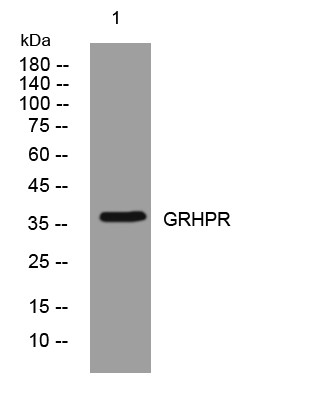- Home
- About
- Promotions
-
Products
-
Elisa Kits
- |
-
Primary antibodies
- |
-
Secondary antibodies
- |
-
Proteins
- |
-
IHC reagents
- |
-
WB reagents
- PonceauS Staining Solution
- PBST Washing Buffer, 10X
- 1.5M Tris-HCl Buffer, pH8.8
- 1M Tris-HCl Buffer, pH6.8
- 10% SDS Solution
- Prestained Protein Marker
- TBST Washing Buffer, 10X
- SDS PAGE Loading Buffer, 5X
- Stripping Buffered Solution
- Tris Buffer, pH7.4, 10X
- Total Protein Extraction Kit
- Running Buffer, 10X
- Transfer Buffer, 10X
- 30% Acr-Bis(29:1) Solution
- Tris电泳液速溶颗粒
- PBS(1X, premixed powder)
- TBS(1X, premixed powder)
- 快速封闭液
- 转膜液速溶颗粒
- Chemical reagents
- News
- Distributor
- Resources
- Contact
- Home
- >
- Info
- >
- GRHPR rabbit pAb
- >
- Go Back
GRHPR rabbit pAb
- Catalog No.:YT6566
- Applications:WB
- Reactivity:Human;Mouse
- Fields:
- >>Glycine, serine and threonine metabolism;>>Pyruvate metabolism;>>Glyoxylate and dicarboxylate metabolism;>>Metabolic pathways
- Gene Name:
- GRHPR GLXR MSTP035
- Immunogen:
- Synthesized peptide derived from human GRHPR AA range: 151-201
- Specificity:
- This antibody detects endogenous levels of GRHPR at Human/Mouse
- Formulation:
- Liquid in PBS containing 50% glycerol, 0.5% BSA and 0.02% sodium azide.
- Source:
- Polyclonal, Rabbit,IgG
- Purification:
- The antibody was affinity-purified from rabbit antiserum by affinity-chromatography using epitope-specific immunogen.
- Storage Stability:
- -15°C to -25°C/1 year(Do not lower than -25°C)
- Molecular Weight(Da):
- 36kD
- Background:
- This gene encodes an enzyme with hydroxypyruvate reductase, glyoxylate reductase, and D-glycerate dehydrogenase enzymatic activities. The enzyme has widespread tissue expression and has a role in metabolism. Type II hyperoxaluria is caused by mutations in this gene. [provided by RefSeq, Jul 2008],
- Function:
- catalytic activity:Glycolate + NADP(+) = glyoxylate + NADPH.,disease:Defects in GRHPR are the cause of hyperoxaluria primary type II (HP2) [MIM:260000]; also known as primary hyperoxaluria type II (PH2). HP2 is a disorder where the main clinical manifestation is calcium oxalate nephrolithiasis though chronic as well as terminal renal insufficiency has been described. It is characterized by an elevated urinary excretion of oxalate and L-glycerate.,function:Enzyme with hydroxy-pyruvate reductase, glyoxylate reductase and D-glycerate dehydrogenase enzymatic activities.,similarity:Belongs to the D-isomer specific 2-hydroxyacid dehydrogenase family.,subunit:Monomer.,tissue specificity:Ubiquitous. Most abundantly expressed in the liver.,
- Subcellular Location:
- cytoplasm,peroxisomal matrix,cytosol,extracellular exosome,
- Expression:
- Ubiquitous. Most abundantly expressed in the liver.

- Western blot analysis of lysates from Jurkat cells, primary antibody was diluted at 1:1000, 4°over night




